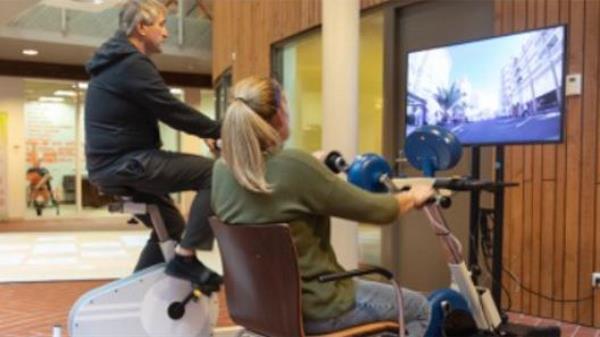Learning to live healthily during rehabilitation (NICE4ALL)
Rehabilitation after illness is an excellent opportunity to achieve a healthy lifestyle with more exercise and a healthier diet. During the rehabilitation process, the patient is consciously exercising to recover.
Centre of Expertise Health Innovation

Rehabilitation after illness is an excellent opportunity to achieve a healthy lifestyle with more exercise and a healthier diet. During the rehabilitation process, the patient is consciously exercising to recover. There is room for focus and there are fewer distractions from daily concerns. However, the current rehabilitation environment is not always equipped in such a way that patients themselves can work on healthy exercise and healthy nutrition. Moreover, after rehabilitation, patients should continue their new lifestyle at home, but how can this be encouraged?
The project NICE4ALL (New Interventions in a Clinical Environment for Active Living and Lifestyle) focuses on the (re)development, implementation and evaluation of technological interventions that promote a healthier lifestyle. Adequate exercise and healthy eating are easier said than done, but technology can help. Examples are games with a playful element that challenge people to get involved.
This project offers patients the opportunity to apply skills learned in therapy independently and in a fun way. This enables them to make a start on sustainably changing their behaviour to achieve a healthy lifestyle.
Healthy exercise research in living lab
The Rehabilitation and Technology Research Group is researching which technological solutions work best to enable more exercise - both during rehabilitation and in the home situation - in a living lab. This is an experimental physical and social 'real life' environment in which all parties involved test various solutions. A donation from the Rabobank Innovation Fund made this possible.
Clinicians, designers and technicians work together with rehabilitation patients, students and lecturers from the Human Kinetic Technology and Communication & Multimedia Design degree programmes and researchers from the research group. The living lab is located in the Atrium of the Basalt rehabilitation centre in The Hague (Vrederustlaan 180).
Solutions to encourage more exercise
The technological solutions can only work if the range of options is accessible and user-friendly. That is why the project also looks at these conditions. The input of all stakeholders is very important.
The following solutions have been developed and implemented over the past two years:
- A 'Community of Practice' has been set up - consisting of former patients, healthcare professionals and other stakeholders - to advise on promising innovations.
- Various technologies are used to encourage rehabilitating patients to get exercising themselves, such as an Active Floor, an interactive touch screen with health information, a Bike Labyrinth with more than 500 routes, SmartClips, AirHockey, Wii games and a balance board.
- A social infrastructure has been set up in which innovation staff and students are available for a chat and can help with the technology. The mobile barista cart, operated by (ex-)rehabilitating patients, also invites a moment of conviviality and meeting.
- Posters have been developed with instructions for the equipment on how to start up and troubleshoot, making it more accessible.
- Social and competitive elements have been added to the technology so that the user wants to use the device or play the game more often.
- Expertise and collaboration have been combined in sub-research by practitioners and patients from Basalt and students and lecturer-researchers from various universities of applied sciences.
Duration
This project runs until September 2022.